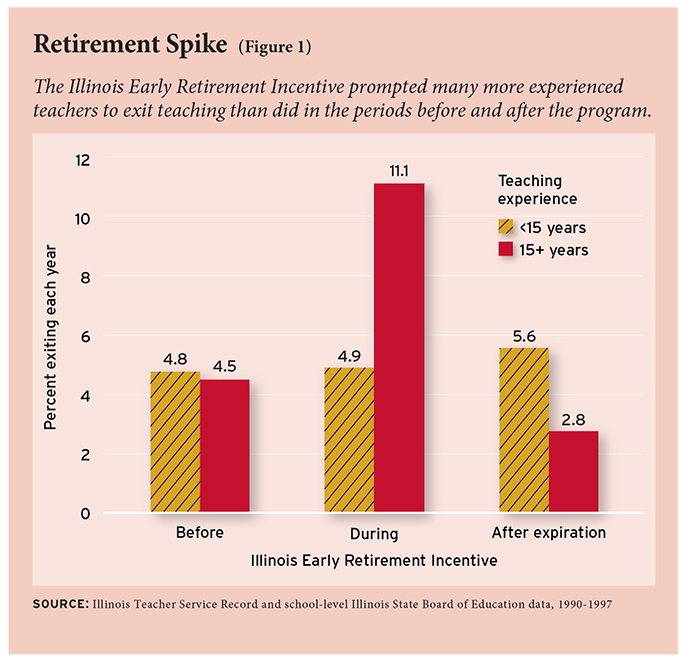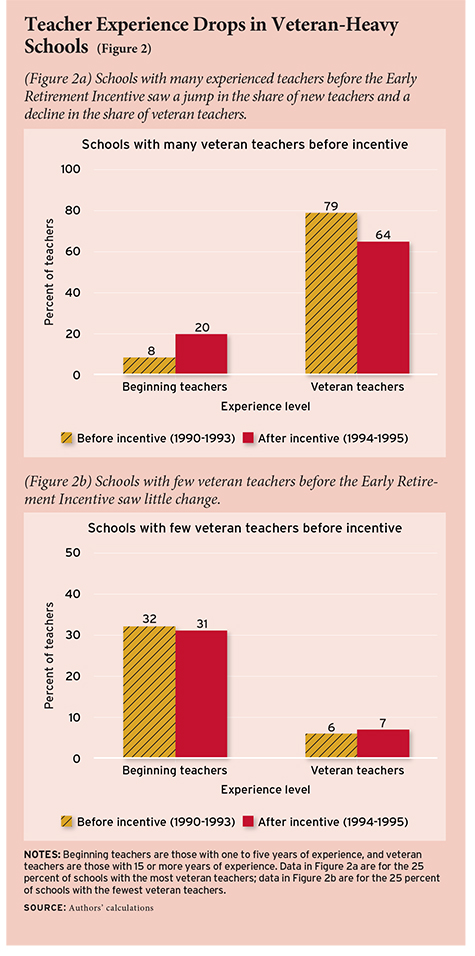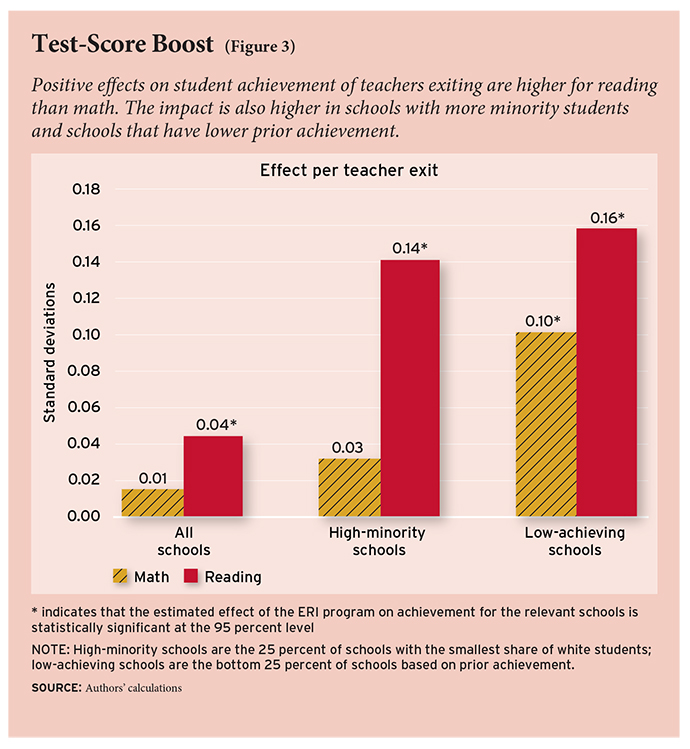As public budgets have grown tighter over the past decade, states and school districts have sought ways to control the growth of spending. One increasingly common strategy employed to rein in costs is to offer experienced teachers with high salaries financial incentives to retire early. Although early retirement incentive (ERI) programs have been around since the 1970s, their popularity has spiked in the past five years, as it has during previous recessions. In 2010 alone, several large states, including New York, Michigan, and Minnesota, enacted ERI legislation. Despite the popularity of ERI programs, little is known about how inducing experienced teachers to retire early affects student achievement.
 The aging of the nation’s teacher workforce underscores the importance of examining how ERI programs influence student learning. Teachers typically become eligible for full retirement benefits based on their age and years of experience. In 2010, more than one-third of teachers were over the age of 50. Given that most teachers begin their careers in their 20s and that retirement rates tend to increase dramatically around 30 years of experience, in the coming decade we can expect a large number of teachers to be at a point in their careers when an ERI may be particularly attractive.
The aging of the nation’s teacher workforce underscores the importance of examining how ERI programs influence student learning. Teachers typically become eligible for full retirement benefits based on their age and years of experience. In 2010, more than one-third of teachers were over the age of 50. Given that most teachers begin their careers in their 20s and that retirement rates tend to increase dramatically around 30 years of experience, in the coming decade we can expect a large number of teachers to be at a point in their careers when an ERI may be particularly attractive.
Research clearly shows that the incentives created by retirement plans affect teachers’ decisions about how long to work before retiring. It is not obvious, however, how large-scale teacher retirements, such as those resulting from an ERI, will affect student academic achievement. On the one hand, retiring teachers are highly experienced, and they typically are replaced with much less experienced or new teachers. If the experienced teachers who retire are more effective than the new hires, teacher retirements could reduce student achievement.
On the other hand, teachers who are near retirement may put forth less effort than younger teachers or may be less well trained in modern, potentially more effective, pedagogical practices. This may be particularly true for those teachers who desire to retire early. Teachers who choose to take up the ERI may be those who are least effective in the classroom. Addtionally, principals and administrators may respond to large losses of experienced teachers, such as by decreasing class sizes or changing the assignment of teachers to students. In these cases, teacher retirements may have no or even a positive effect on student learning.
The main difficulty in measuring the effect of teacher retirement on student achievement is that retirement decisions may both affect and be affected by student performance. For example, teachers may retire rather than face a lower-performing group of students. The opportunity for teachers to retire early exacerbates the measurement challenge, as early retirement programs give teachers greater flexibility in deciding when they leave teaching.
To overcome this challenge, we take advantage of a natural experiment brought about by a two-year ERI program offered by Illinois in the early 1990s. This short-term program led to the retirement of 10 percent of Illinois teachers in a two-year time span. We compare changes in student performance in schools that were more affected by the policy because they employed more experienced teachers to changes in schools that were less affected. We find the program did not reduce test scores; likely, it increased them, with positive effects most pronounced in schools that serve a more disadvantaged student population. We also find that, while this particular program produced a net cost to taxpayers, it is likely that a carefully designed program could produce similar results at a lower cost.
The Illinois Early Retirement Incentive
The Illinois Teachers Retirement System (TRS) is a defined benefit pension plan. Employee contributions are made over the course of employment, and benefits are paid out upon retirement. During the period studied, the employee contribution rate was 9 percent of earnings, and the benefits formula was based on employees’ years of service and salary at the time of retirement. The maximum annual benefit employees could receive was 75 percent of their end-of-career salaries.
In general, TRS teachers can claim retirement benefits when they end active service with Illinois Public Schools (IPS) and meet the following age and service requirements: age 55 with 35 years of service, age 60 with 10 years of service, or age 62 with 5 years of service. If a teacher is at least 55 years old and has at least 20 years of experience, she may start collecting pension benefits, but they will be discounted by 6 percent for each year she is below age 60. An early retirement option exists, whereby members who are at least 55 years old and who have at least 20 years of service can receive their full benefit if both the employee and the employer pay a one-time fee.
In 1992–93 and 1993–94, employees were offered an ERI as an alternative to the standard early-retirement option. This ERI, called the “5+5,” allowed employees to buy up to an additional five years of age and service credit. As long as the member was at least 50 years old and had accumulated five years of service credit, she and her employer could pay a one-time fee to increase her retirement benefit as long as the teacher retired immediately. The fee for employees was 4 percent of the highest annual salary for each of the additional years of age and service purchased; the fee for employers was 12 percent of the employee’s highest annual salary for each year purchased.
The 5+5 program was very generous to experienced teachers in that most teachers who were at least 50 years old and who had at least 15 years of experience could realize large potential gains in compensation. The generosity of the ERI program is probably the reason it generated a significant increase in teacher exit among experienced teachers (see Figure 1).

Data
We use three sources of data on Illinois teachers and students collected by the state. First, the Teacher Service Record (TSR) is an administrative data set that tracks where IPS employees work and their number of years of creditable experience in the retirement system. These data let us follow an employee across schools and as she enters and exits IPS. We include in our study only those staff members who serve as regular classroom or special education teachers.
Standardized testing in Illinois in the early 1990s focused on 3rd-, 6th-, and 8th-grade students, so we restrict most of our analysis to teachers in those grades. The TSR contains 253,463 observations of 54,550 unique teachers in 3rd, 6th, and 8th grades during our analysis period. For these teachers, we measure teacher experience using the reported total years of experience both in IPS and outside of Illinois. There is a great deal of variation in the average experience of teachers across schools. On average, Illinois elementary and middle schools have 9.4 teachers in these grades, 5.2 of whom have 15 or more years of experience prior to the ERI program.
We also use the teacher-level data to calculate exit rates of experienced teachers, average experience in all years, and the proportion of new teachers in each school and year. One drawback of this dataset is that it does not track teacher retirement or ERI program participation directly. Because the data cover the entire state, however, we can gauge the effect of the ERI program on retirement by observing the change in exit rates of experienced teachers when the program was implemented.
The second set of data includes school-level information on test scores for certain grades and subjects, collected since the early 1990s as part of Illinois’ ongoing accountability program. During the period covered by our study, the IPS administered exams in math and English in grades 3, 6, and 8. We observe the average score by school, year, and grade on each exam, which we scale to have a mean of 0 and standard deviation of 1 in each year, grade, and subject.
Finally, we make use of information on the demographics of students in schools as reported to the Illinois State Board of Education. These data include the percentage of students who are from low-income families; the percentage who are white, black, Hispanic, Asian, or Native American; and the percentage who are Limited English proficient (LEP). The school districts also record attendance rates and grade-specific enrollment for each school and year.
We focus our analysis on the 1989–90 through 1996–97 school years, because the earliest available data are from the 1989–90 school year, and in 1998 the Illinois legislature changed the teacher benefit formula in ways that could influence teacher retirement decisions.
Methodology
 To measure the effect on test scores of the retirements resulting from the ERI program, we exploit the fact that teachers with more years of experience were much more likely to be affected by the program. The earliest age at which retirement benefit collection could have taken place before the ERI is 55; with the ERI, teachers can retire at age 50 or older. Most teachers aged 50 years or older have at least 15 years of experience, so we expect the ERI to have influenced the retirement behavior of teachers with at least 15 years of experience disproportionately. And our data confirm that teachers in this group were substantially more likely to leave the Illinois school system once ERI went into effect. A similar change in behavior did not occur for less-experienced teachers, as shown in Figure 1. As a result, schools with many veteran teachers saw large declines in teacher experience when the ERI went into effect. In contrast, experience levels in schools with few veteran teachers increased slightly, as fewer of their teachers retired and those who remained gained experience (see Figure 2).
To measure the effect on test scores of the retirements resulting from the ERI program, we exploit the fact that teachers with more years of experience were much more likely to be affected by the program. The earliest age at which retirement benefit collection could have taken place before the ERI is 55; with the ERI, teachers can retire at age 50 or older. Most teachers aged 50 years or older have at least 15 years of experience, so we expect the ERI to have influenced the retirement behavior of teachers with at least 15 years of experience disproportionately. And our data confirm that teachers in this group were substantially more likely to leave the Illinois school system once ERI went into effect. A similar change in behavior did not occur for less-experienced teachers, as shown in Figure 1. As a result, schools with many veteran teachers saw large declines in teacher experience when the ERI went into effect. In contrast, experience levels in schools with few veteran teachers increased slightly, as fewer of their teachers retired and those who remained gained experience (see Figure 2).
The number of teachers in each grade at a school who had at least 15 years of experience prior to ERI therefore serves as our measure of “treatment intensity,” by which we mean that schools that had more such teachers were more affected by the policy than schools with fewer experienced teachers. Differences across schools in treatment intensity enable us to measure the impact of ERI-induced retirements on test scores. Specifically, we measure whether test scores changed to a greater (or lesser) extent in schools that had, in the pre-ERI period, a greater number of experienced teachers relative to schools that had fewer experienced teachers. As we make this comparison, we also take into account any preexisting differences in student achievement across schools that may be related to the experience profile of teachers as well as any changes over the period of our study in the student demographic variables discussed above.
The main assumption underlying our analysis is that, in the absence of the ERI program, schools with different teacher-experience levels in the pre-ERI period would have had the same trends in student test scores. We find that, prior to the introduction of ERI, teacher-experience levels were not associated with changes in test scores, suggesting that this assumption is valid and that our results can be interpreted as the effect of ERI-induced retirements on test scores.
Results
Before examining how the ERI affected student academic achievement, it is important to understand how it affected schools through changes in retirement patterns, teacher-experience levels, and school resources. We use our methodology to measure the impact of ERI on the number of experienced teachers who exit the school system, average teacher-experience level, the proportion of new teachers, and student-teacher ratios. These results show how the ERI changed the characteristics of the teacher workforce.
First, we find that having one more teacher with 15 or more years of experience in a school before ERI increased the number of experienced teachers exiting each year during the ERI period by 33 percent. The increased exit among more-experienced teachers was accompanied by declines in average teacher experience of 0.41 years, or 2.6 percent, for every teacher with 15 or more years of experience before ERI. This drop in average experience was driven in part by an increase in the number of new teachers. Overall, for each teacher with 15 or more years of experience before ERI, the number of new teachers in a school increased by 0.073, or 20 percent. In other words, schools with more veteran teachers before the creation of the ERI program experienced much larger changes in teacher turnover and declines in teacher experience when the program was implemented than schools with fewer such teachers.
Although retirements under the ERI program occurred quickly and unexpectedly, the possibility remains that administrators made changes in areas other than their teaching staffs to compensate for the loss of experienced teachers. Such offsetting behavior would be of interest in its own right, and we stress that our test-score results below reflect the effects of any such changes. Unfortunately, detailed data on curriculum, resources, and expenditures are not reported in ways that would prove useful for measuring this type of behavior. The only potentially important resource measure we can observe is pupil-teacher ratios, and we find no consistent evidence that ERI altered the number of students per teacher in the schools it affected most.
Although ERI had a substantial impact on the experience level of teachers in Illinois schools with many teachers eligible for early retirement, those changes do not appear to have had a negative impact on student achievement. Our estimates indicate that, for each teacher who left under the ERI, test scores increased by 0.01 and 0.04 student-level standard deviations in math and reading, respectively. Both of these estimates are quite small, and only the estimate for reading is statistically significant. But they point in a positive direction, and are precise enough that we can rule out the possibility that teacher departures due to the ERI had even small negative effects.
Given that the median retiring teacher had 27 years of experience and was replaced by a teacher with less than 3 years of experience, the fact that these retirements had little effect on student achievement is puzzling. In a recent review of existing research on teacher experience, the University of Arizona’s Matthew Wiswall concludes that new teachers perform between 0.10 and 0.18 standard deviations worse than experienced teachers. Since we find no support for the notion that schools reduced pupil-teacher ratios in order to counteract the potential negative impact of teacher retirements, we suspect that the teachers who took up the ERI were less effective than the ones who replaced them or than the ones remaining in the school.
Our results suggest that the teacher retirements caused by the ERI program did not reduce student achievement on average, and they may even have increased it. However, there could have been different effects in different schools that were driven, at least in part, by the fact that wealthier or higher-achieving schools may find it easier to replace retiring teachers with experienced teachers from other schools. We address this question by calculating the ERI effect on student achievement for schools that are similar in the percentage of students from low-income families, the percentage of students who are white, and pretreatment average test scores. The results point to increases in student achievement from teacher retirement that are, if anything, larger for disadvantaged schools—the opposite of what we might have expected (see Figure 3).

In sum, although the Illinois ERI program led a large number of experienced teachers to retire, and thereby lowered teacher experience levels, the program did not reduce test scores and instead led to increased student achievement in most cases.
Why would test scores improve when large numbers of experienced teachers retire? As noted above, it could be that less-effective teachers are more likely to take advantage of ERI opportunities, causing test scores to rise as these teachers are replaced with newer ones. If that is the case, our results yield information on the effect of ERI programs on student achievement, but it could be misleading to use them to predict the effects of the impending spike in teacher retirements due to the aging of the teacher workforce. Given available data, it is not possible to examine the effectiveness of teachers who responded to the ERI. But the implication of our results is clear: offering expiring incentives for late-career teachers to retire does not harm student achievement on average.
Policy Implications
From a broader policy perspective, our estimates suggest that ERI programs could be beneficial for school districts, saving them money on teacher salaries without harming student achievement. Along these lines, it is important to consider the costs of this program to both school districts and the state, as well as the value of any increases in test scores that occurred because of the program.
Because of the ERI, the median teacher retired 5 years earlier than she would have otherwise, at age 55 with 27 years of service rather than at age 60 with 32 years of service. Since replacing a 27-year veteran teacher with a novice one saves $20,772 per year on average, this would result in savings per employee to the district with a net present value of $95,306. (This figure, and all those which follow, are discounted using a 3 percent real interest rate.) For each year of creditable service purchased through the ERI, however, the district has to pay 12 percent of the teacher’s salary in a lump-sum payment. Since the median teacher bought five years of service, the median lump-sum payment made by the district was 60 percent of a teacher’s salary, or $26,493. Taking into account both costs and savings across the approximately 8,000 teachers who took advantage of the Illinois program, ERI resulted in savings to IPS districts of $550.5 million.
Teachers who retired early because of the ERI, however, could expect to receive pension benefits for more years than if they had retired later. In Illinois, the state, rather than the districts, must make up the increased costs to the pension system of these ERI retirees. The median ERI retiree received $115,677 of increased benefits from retiring five years earlier. The teacher also had to pay a lump-sum amount equal to 4 percent of her salary per year purchased. Accounting for the district and teacher payments, the net cost to the pension system was $80,352 per ERI retiree, or $642.8 million to the pension fund. Therefore, the total cost to the state’s taxpayers—the sum of the net benefit to the districts and the net cost to the pension fund—was approximately $92.3 million. Since there were approximately 1.8 million students in IPS in 1993, this represented a cost per student of $51.
In other words, even when an ERI program creates substantial savings for school districts by reducing teacher salary costs, it still can cost the state money through higher pension payments. This was clearly the case in Illinois.
This likely unintended cost can be weighed against the unintended benefit of higher test scores. Our results suggest that the average effect of the ERI on test scores was between -0.002 and 0.029, with an average effect of 0.010 standard deviations. Taken together, the cost and benefit estimates suggest that taxpayers paid $51 per student in return for an increase in test scores of 1 percent of a standard deviation. At worst, the taxpayers of Illinois paid $51 per student and saw test scores decrease by 0.002 of a standard deviation, a negligible amount.
In short, early retirement incentives can provide a means for districts to save money without hurting student achievement. With better policy design, it may be possible for such a program to save taxpayers money as well.
Maria D. Fitzpatrick is visiting scholar at the National Bureau of Economic Research and assistant professor of policy analysis and management at Cornell University, where Michael F. Lovenheim is associate professor of policy analysis and management.
This article appeared in the Summer 2014 issue of Education Next. Suggested citation format:
Fitzpatrick, M.D., and Lovenheim, M.F. (2014). Early Retirement Payoff: Incentive programs for veteran teachers may boost student achievement. Education Next, 14(3), 70-76.


